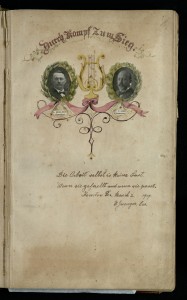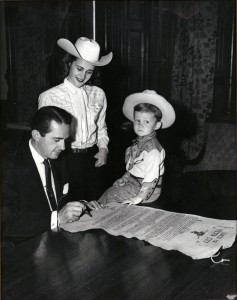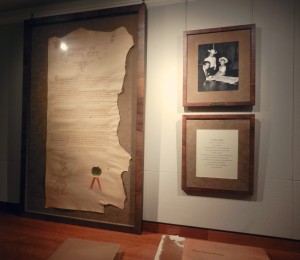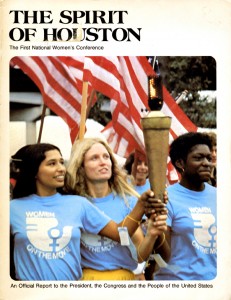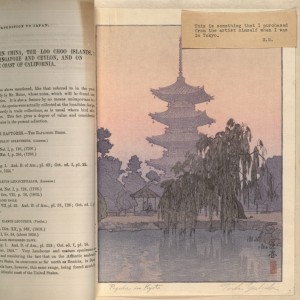
The University of Houston Special Collections is happy to announce both the recent publication of the Houston Saengerbund Records in the UH Digital Library and significant additions and revisions made to the finding aid for the related physical collection housed here in Special Collections!
The Houston Saengerbund is a German singing society that has been active in Houston for more than a century and continues to perform at public events throughout Houston and Texas to this day. It was founded in 1883 and was one of many all-male singing organizations which formed in the German communities of Texas during the last half of the 19th century. These local groups were united under Der Deutsch-Texanische Saengerbund (the German-Texan Singers’ League), a regional organization that held biennial meetings and Saengerfeste (Singing Festivals) in various Texas cities. Both the digital collection and physical materials provide insight not only into the activities, performances, membership, and administration of this group, but also into its responses to major events and social changes throughout the last century of American history.
The digital collection consists of five bound ledgers covering the years 1874-1937. In these ledgers you’ll find meeting minutes, financial statements, programs, clippings, and correspondence between the Houston Saengerbund and other German organizations. The materials span the time from the group’s inception, through its growth to over 1000 members in the years before World War I, and to the formation of the Ladies Auxiliary and the Damenchor (Women’s Chorus) in 1937.
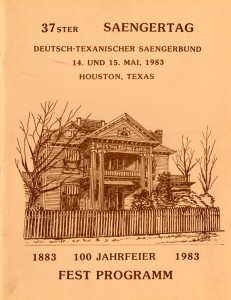
Program from the 1983 Texas Saengerfest, held in Houston and also marking the Houston Saengerbund’s centennial
The updated finding aid describes physical materials dating from 1874 to present. Here you’ll find songbooks and event materials, administrative records, legal files, financial records, and publications from all points in the group’s history. Of particular interest is the effect of anti-German sentiment that developed during the World Wars. With the onset of World War II, the Saengerbund members changed the name of the group to “The Houston Singing Society,” quit their primary activity of singing German songs, and began keeping minutes in English due to their concern about arousing anti-German sentiment. It wasn’t until after the war ended that the club members restored both their singing and their name.
The events mentioned above are just a couple of the points of interest to be found in the rich and storied history of The Houston Saengerbund. Check out the digital collection or visit us here in Special Collections to find out more!
Whether it’s a rare book printing found at long last or piece of ephemera found in an archival collection by chance, those who visit the University of Houston Special Collections almost always find something they cannot wait to share with others. Here we celebrate what makes the University of Houston Special Collections so special–our Favorite Things.
University Archivist Mary Manning recommends a very timely item from our collections for our latest favorite–the Fiesta City charter.
It is that time of year, as spring has ushered in a veritable city-within-a-city on the campus of the University of Houston in one of our oldest traditions. Along Scott Street, in the shadow of TDECU Stadium, the student body has built, once again, our fine Fiesta City, home of Frontier Fiesta. A combination of variety shows, cook-offs, and concerts, Frontier Fiesta officially opened last night and runs through this weekend featuring entertainment for everyone.
Our University Archives preserve and make available for study the history of this tradition via the UH Frontier Fiesta Collection. Containing newspaper clippings, photographs, correspondence, show scripts, and event programs dating all the way back to 1941, the UH Frontier Fiesta Collection is open for research to anyone interested in tracing the event’s history (including the students who lead and run this massive undertaking each year).
But still, it’s not really a city, right?
Well, sometimes there is more to a name than just a cute, simple moniker.
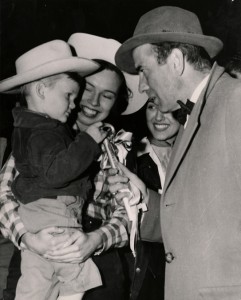
Honorary Mayor Johnny Goya III presents Humphrey Bogart with the key to Fiesta City (1952, UH Frontier Fiesta Collection)
Last spring, Manning curated an exhibition of some of these materials entitled “Frontier Fiesta: The Greatest College Show On Earth.” While many items in the exhibit garnered attention from those interested in the history of this long-standing fixture on the UH calendar, Manning noted one item of particular significance. In Houston History, reflecting on the Fiesta and what the records reveal of its history, Manning writes, “Especially noteworthy is Fiesta City’s charter drawn up by students in 1952 and branded onto a tanned cowhide by student Betty Rich and taken to Austin for Governor Allan Shivers’s signature.”
Far from any, ahem, branding ploy, this cowhide proves that a bonafide city recently sprung up on a grand swath of asphalt in the heart of the Third Ward, hosting a tradition that is uniquely Houston. Those interested in viewing Fiesta City’s charter, complete with the still-just-visible signature of Governor Shivers proclaiming it a city “happily free of municipal corruption, yankees, and other dangerous influences,” may do so in the Special Collections Reading Room during our normal research hours. Enjoy the Fiesta, and Fiesta City, Houston!
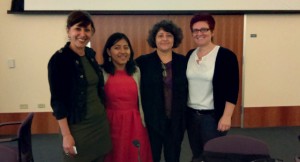
Dr. Maria Cotera (left) alongside panelists Lisa Cruces, Patricia Hernandez, and Dr. Carolina Villaroel
The University of Houston recently hosted Dr. Maria Cotera of the University of Michigan and her talk, “Decolonizing the Archive: Chicana por mi Raza and the Challenge of Digital Humanities.” Dr. Cotera’s talk focused on her work with Chicana por mi Raza, a public humanities project centered on the collection and digital preservation of archival materials, ephemera, and oral histories that document the development of Chicana feminist thought during the civil rights era. A panel discussion, “Pushing Back: Chicana, Latina, Hispanic Women Preserving our Narratives,” followed Cotera’s talk and featured the founder of Studio One Archive Resource, Patricia Hernandez, Director of Research for Arte Público Press, Dr. Carolina Villaroel, and the first Hispanic Collections Archivist at the University of Houston, our own Lisa Cruces.
Sponsored by a number of organizations on and off campus, Dr. Cotera’s talk was broadly attended and included students, staff, and faculty from UH as well as local universities and high schools. The “digital turn,” Dr. Cotera argues, has allowed for a certain de-centering of authority in the work of scholarly research and the Chicana por mi Raza project establishes a collaborative venue providing broad-based public access to oral histories, correspondence, and out-of-print publications for scholarly research in and out of the classroom. Her work with Chicana por mi Raza represents a challenge to the pedagogy and influence of archival politics, prejudices, and patriarchal legacy of the existing structure. The result is a democratization of the archives and an engagement with communities that have been underrepresented in more traditional research models.
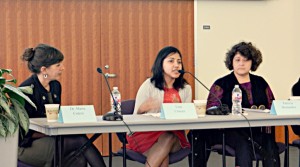
Lisa Cruces (center), Archivist for the Hispanic Collections, addresses a question from the audience during the panel discussion
The panel that followed provided attendees an opportunity to ask questions and hear from women in the field with a variety of traditional and non-traditional archival backgrounds address the subtleties, nuance, and challenges of preserving the historical narratives in this new landscape. As Archivist for the Hispanic Collections here at UH, Cruces certainly has faith in aspects of the traditional archival models, but pointed out that Cotera’s work necessitates the bringing together of multiple vested interests and provides a great opportunity to partner with members of the community outside of the traditional institutional walls. In turn, this work allows a means of introduction to the archives while also allowing participants to look critically as to how historical memory is collected.
If you are interested in the collection and preservation of that historical memory, we encourage you to visit our Hispanic Collections at the University of Houston Special Collections.
In addition to the over 7,000 linear feet of archival collections made available for study at the University of Houston Special Collections, we are also proud to offer over 100,000 rare and antique books for use in our reading room. Each month we will highlight a text from our collections and what makes it so special.
Book of the Month: The Spirit of Houston. The First National Women’s Conference. An Official Report to the President, the Congress, and the People of the United States, published by President Jimmy Carter’s National Commission on the Observance of International Women’s Year.
Why so Special? A number of reasons, really.
First, there’s the timing. Whether you’ve been celebrating Women’s History Week since 1981 or you go all the way back to 1909 and celebrated International Women’s Day last weekend, one thing is certain–March is Women’s History Month. Then, what time like the present to view this report and delve back into a history that captures a moment in time when so-called second-wave feminism was on the rise, the world was beginning to notice, and, for a moment, Houston found itself at the epicenter of the domestic debate and struggle.
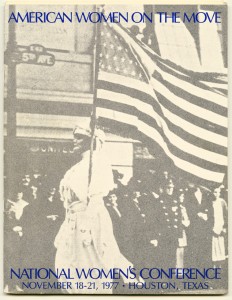
cover of “American Women on the Move, National Women’s Conference” (1977, Marjorie Randal National Women’s Conference Collection)
The timing of the events that brought about this report is also worth noting. When the United Nations declared that 1975 would be “International Women’s Year,” President Gerald Ford established the National Commission on the Observance of International Women’s Year. In the wake of 1975, the work taken on by UN partnerships, and the issues and questions raised from the World Conference of the International Women’s Year (held in Mexico City in the summer of 1975), President Carter’s Commission proposed a National Women’s Conference to take place in Houston in 1977. That November 2,000 delegates from all fifty states and six territories descended on Houston along with an estimated 20,000 observers in attendance. Included among these numbers were first ladies, activists, artists, writers, and more. The topics addressed and reported on by the Conference seemed to buoy support for the floundering Equal Rights Amendment on through 1978. President Carter expressed as much in his comments on the one-year anniversary of the Conference, including ratification of the ERA to be among the goals necessary “for all citizens to participate fully in every part of American life.”
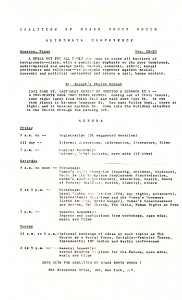
The National Women’s Conference was not the only conference in town: agenda for the “Coalition of Grass Roots Women Alternate Conference” (1977, Marjorie Randal National Women’s Conference Collection)
Or, maybe what makes this report so special is the tip of the research iceberg it represents. The Spirit of Houston… is just one title in the larger Peggy Hall Collection. Hall was a charter member of Houston Area NOW, active member of the Harris County Women’s Political Caucus on issues related to the ERA, and witness to the events of 1977. Examples of other works comprising the collection bearing her name include Notes from the Third Year: Women’s Liberation (a collection of radical feminism that includes Judy Syfers’ biting essay “I Want a Wife,” just prior to its appearance in the premier issue of Ms. magazine) and the iconic 1972 Our Bodies, Ourselves. But, if you had rather keep your focus on the First National Women’s Conference, maybe you would be interested in the Marjorie Randal National Women’s Conference Collection. Randal, an active supporter of women’s rights in the greater Houston-Galveston-Gulf Coast region, was also involved in the events of 1977 and played critical roles in establishing local NOW chapters. Her collection features correspondence, newsletters, publications, and other assorted materials dating from the mid 1970s into the 1980s, with the bulk of the materials focusing on the critical year of 1977 and the National Women’s Conference.
Location: The Spirit of Houston… is available for study this and every month in the University of Houston Special Collections Reading Room (call number HQ1403.N34 U54 1977). Interested in viewing this report or any of the other resources mentioned above? Then, we look forward to your visit to Special Collections.
Whether it’s a rare book printing found at long last or piece of ephemera found in an archival collection by chance, those who visit the University of Houston Special Collections almost always find something they cannot wait to share with others. Here we celebrate what makes the University of Houston Special Collections so special–our Favorite Things.
Today Sara Craig, University Archives Student Assistant, offers us one of her favorites.
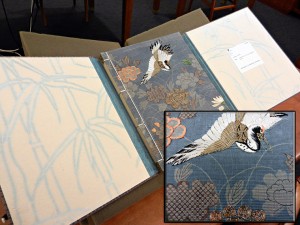
cover of the Narrative of the expedition of an American Squadron to the China Seas and Japan, v.1; inset: detail of embroidery
One of my favorite things in the UH Special Collections is the series of 13 volumes of the Narrative of the expedition of an American Squadron to the China Seas and Japan donated by Maury Maverick, a Texas Congressman in the late 1930s. The Narrative itself was compiled from the journals and notes of Commodore M. C. Perry and his officers during a trip to Asia from 1852 to 1854, first printed commercially in 1856. What makes this particular set so fantastic is the care that went into the binding and creation of each volume. Each individual book is unique, with a soft cover Japanese four-hole stab-bound (Yotsume Toji) book ensconced in a tri-fold hardcover case. These books are considered to be extra-illustrated, that is the creator of the books took the narrative and added in extra pages containing maps, prints, newspapers and other ephemera before rebinding, creating a unique and unusual set of books.
Extra-illustrated books were an unusual fad that was popular in the late 18th to early 19th century in England and the United States. Collectors of extra-illustrated books would pay to have an original printed book taken apart and rebound with added letters, maps, prints and pages from other books. Often the rebound books would be encased in gilt and leather bindings. Occasionally the extra-illustrations in a book refer to sketches, drawings and small paintings included in an original binding of a book.
Some of the extra information added, including the newspapers, deal with the aftermath of World War Two and the signing of the treaty with Japan. There are also items of a personal nature included, a letter from J. Edgar Hoover to Maury Maverick and personal letters from President Truman and his wife, Bess Truman, to Maury Maverick and his wife. Other items appear to be ephemera gathered by Mr. Maverick during his travels in Asia, postcards, Christmas cards and woodblock prints.
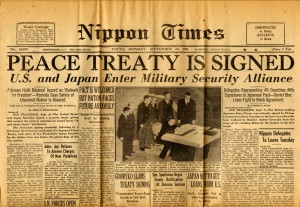
“Peace Treaty is Signed” – cover of the Nippon Times, September 10, 1951, tucked inside volume one of the Narrative of the Expedition…
What first intrigued me about these books, however, was not the information contained within. The visual appeal of the books is obvious. The beautiful book cloth covering each individual volume, each a different pattern, some small and woven, others either created using a wax-resist technique or hand-printed to appear so, is eye-catching as you walk down the aisle in the book stacks. Once you open each volume, the actual bound books are covered in a completely different and unique book cloth that complements the exterior case. Some of the interior book covers have areas of hand-embroidery; others appear to be hand-printed.
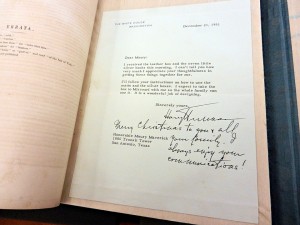
extra-illustrated: as part of the rebinding process, inserted and included is this hand-signed letter from Harry Truman to Maury Maverick (December 21, 1951)
For individuals who are interested in Asian history and culture, both historic and more recent, these volumes are particularly wonderful resources. They are also nice examples of extra-illustrated books, of interest to individuals with an enthusiasm for unusual books or artists books. Even fans of scrapbooking will find looking through this set of books might give them ideas for future projects.
